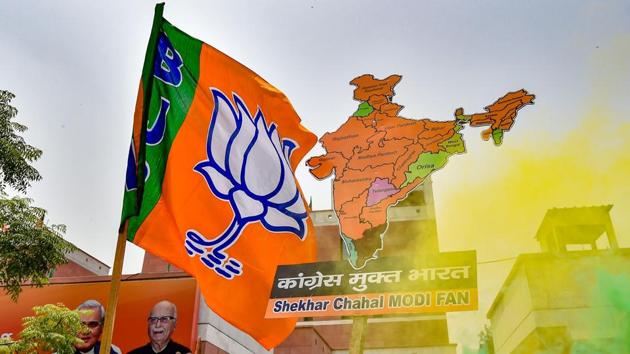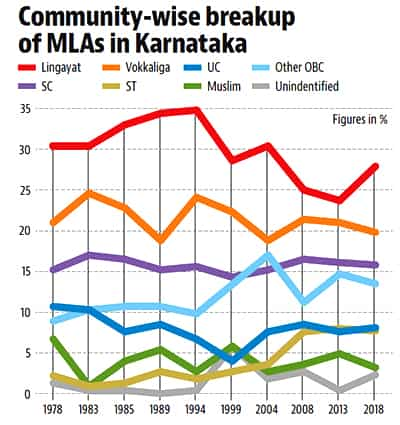Rise of Lingayats, missing women: A profile of the new Karnataka assembly
The political class in Karnataka remains quite concentrated, a phenomenon reinforced by the fact that many politicians switch sides between elections.
A rapid examination of the sociological profile of the new assembly of Karnataka reveals a few interesting trends. Lingayats and Vokkaligas, who traditionally have been well represented across major political parties, are now more polarised between the Bharatiya Janata Party (BJP), which provides the largest share of their representation, and the Congress-Janata Dal (Secular), who provide more representation to Vokkaligas.

The overall turnover of the assembly — which is a measure of how many new MLAs are elected — is 36%, which by Indian standards is not particularly high. The political class in Karnataka remains quite concentrated, a phenomenon reinforced by the fact that many politicians switch sides between elections.
This election further confirms a past trend, which is that Karnataka is one of the worst states in India with regards to women representation. Only six women made it to the assembly, a figure similar to their representation in 2013.
Lingayat resurgence
Much has been said and written about the importance of caste in Karnataka politics. As is well known, the state has been dominated over time by two communities — Lingayats and Vokkaligas. Both are concentrated in different parts (Lingayats in the north, Vokkaligas in the south) and both communities traditionally get representation from all major parties, which reinforces their hold over politics.
Data about recent elections, however, shows a certain erosion of that domination, particularly of the Lingayats, who have been declining from 35% in 1994 to 24% in 2013. The representation of Vokkaligas has been stable through time.
The overall representation of other OBC groups, notably the Kurubas, to which the former chief minister Siddaramaiah belong, has also increased in recent years.
Also read: Mapping the Karnataka election results, constituency after constituency
This reflects the fact that Karnataka elections have become more competitive recently, at least caste-wise. The old model of a state politics dominated by two major groups gradually gave way to a more competitive setting, in which parties must tailor their electoral strategies according to local circumstances.
The 2018 election marks a reversal of sorts of that trend. Both the Congress and the BJP banked massively on the two traditionally dominant communities, and they did so in ways that resulted in more polarisation than before.

The Congress distributed tickets to Lingayats and Vokkaligas in areas where they had been elected in 2013 (regardless of the party affiliation). The BJP adopted a different strategy, banking on a split in votes between Congress and JD(S) Vokkaliga candidates.
The saffron party fielded a large number of Lingayat candidates in Vokkaliga strongholds in south and in coastal Karnataka, and fielded Vokkaligas mostly in central Karnataka, where mostly non-dominant Other Backward Classes (OBC) were elected in 2013. In the south, they gave preference in ticket distribution to non-dominant OBCs. This decision probably cost them quite a few seats and thus their majority.
That being said, the BJP performance across the state and its strategy to field large numbers of Lingayat candidates (66) means that the overall representation of Lingayats in the assembly increases from 24% to 28%. The overall representation of Vokkaligas remains stable.
A party-wise break-up of the caste data reveals a state of greater polarisation between those two communities and political parties. Sixty-five per cent of the Lingayat MLAs and only 20% of the Vokkaliga MLAs are with the BJP. The Congress and JD(S) together make up 35% of the Lingayat MLAs and 80% of the Vokkaliga MLAs.
The BJP has increased its share most among the non-dominant OBCs, winning 18 seats compared to five in 2013.
This means that, at least in terms of sheer representation, the efforts made by Siddaramaiah to woo Lingayats did not pay off.
The geography of caste reveals that the situation hasn’t changed much between 2013 and 2018. Lingayats have made inroads in central Karnataka but otherwise remain clustered in the north of the state. The Vokkaliga clusters and the non-dominant OBC clusters remain largely intact in the south and in coastal Karnataka.
This reveals that if party performance varies over time, the caste geography of Karnataka politics remains stable.
Local volatility
How experienced is the new assembly? We measure that by looking at the performance of re-running incumbents (and former MLAs who contested) and by the share of newcomers in the assembly.
Eighty-two MLAs have won for the first time. Most of them are from BJP (36), then Congress (27) and JD(S) (14). One hundred and eighty two sitting MLAs re-ran in 2018, of which 87 retained their seats. Nearly half of the Congress sitting MLAs who contested this time retained their seats (45) while 30 out of 47 BJP incumbent MLAs won. The JD(S) retained 12 seats with its sitting MLAs, winning 25 seats with newcomers.
Overall, the Congress retained 48 seats, BJP 27 and JD(S) 17. This means that most seats (129) actually changed hands. The BJP won 58 seats previously held by Congress, and 10 by JD(S). The Congress could only win nine seats previously held by BJP but took 13 seats previously held by JD(S). This means that if the BJP won many new seats, it also lost quite a few seats that it had won in 2013.
Karnataka politics is reputed for the pragmatism of its politicians. Over the years, many MLAs have been switching sides ahead of incoming elections. In 2018, 87 candidates switched sides before the campaign, including 23 sitting MLAs and 31 former MLAs. Only six of them deserted the BJP, to contest on Congress or JD(S) tickets. Fourteen Congressmen left their party to try their luck elsewhere. Seven ran on a BJP ticket (three of them won) and five on a JD(S) ticket (only one won).
The JD(S) lost the largest number of leaders, with 23 of them contesting on different party tickets: 13 with BJP, 6 of whom won, and nine with Congress (3 of whom won).
Overall, only 36% of the contesting turncoat candidates won.
The picture that emerges from these numbers is a political class that remains quite stable. The number of newcomers, at 36%, is much lower than the national average (those figures revolve around 60% for states like Uttar Pradesh and Gujarat). This indicates a high level of power concentration with a small-sized political class.
Missing women
There is finally one area in which the new assembly does not differ from the previous ones. Only six women were elected out of 208 contestants. The number of women fielded by major parties remained stable, at 29. Three women were elected on BJP tickets (K Poornima in Hiriyur, Roopali Naik in Karwar and Shashikala Annasaheb Jolle in Nippani) and three on Congress tickets (Laxmi Hebbalkar in Belgaum, Anjali Nimbalkar in Khanapur and Roopakala M. in Kolar Gold). The JD(S) women candidates finished a distant third in their respective constituencies.
With only 2.7% of women MLAs, Karnataka registers one of the lowest women representation ratio in the country. This number has been stable since the early 1990s.
(Gilles Verniers is assistant professor of political science and co-director of the Trivedi Centre of Political Data, Ashoka University. Sudheendra Hangal, Basim-U-Nissa, Sudesh Prakash Singh, Shivangi Titekar and Mohit Kumar contributed to the data. The caste data was collected by Ashish Ranjan during the campaign. The essay is a part of a collaboration between HT and TCPD)
Get Current Updates on India News, Lok Sabha Election 2024 live, Infosys Q4 Results Live, Elections 2024, Election 2024 Date along with Latest News and Top Headlines from India and around the world.



